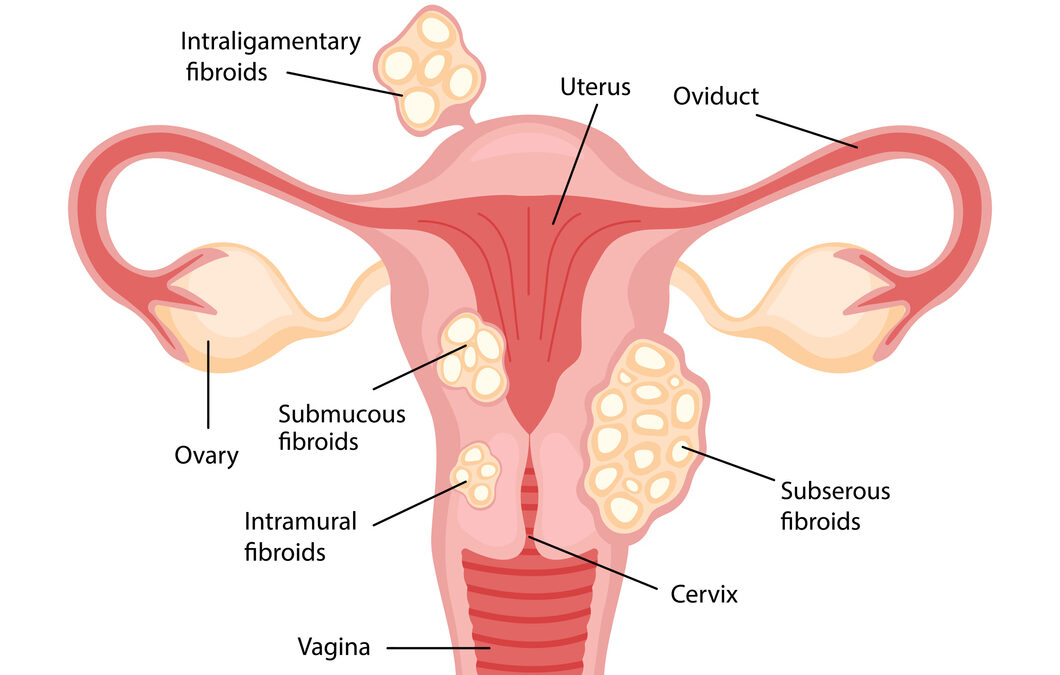Uterine fibroids: what are they?
Uterine fibroids (or myomas) are benign (non-cancerous), solid growths or tumors that originate from the muscle tissue of the uterus. Uterine fibroids affect women of childbearing age as they respond to the influence of estrogen. About 25% of white women and 50% of black women develop symptomatic fibroids. Fibroids represent the most frequent benign female tumors and usually affect women by 50 years of age.
Uterine fibroids: types of fibroids
Uterine fibroids consist of smooth muscle cells mixed with fibrous tissue. Some women have a single uterine fibroid while others have multiple fibroids. Uterine fibroids develop toward the uterine cavity (submucosal fibroids), in the thickness of the uterine wall (intramural fibroids) or toward the outside of the uterus (subserous fibroids). The size of each fibroid can vary greatly.
Uterine fibroids: what are the causes?
It is not known exactly what causes uterine fibroids, but their origin is influenced by genetic predisposition and susceptibility to hormonal stimulation. In other words, some women may have a family history of uterine fibroids and some may simply be more sensitive to reproductive hormones. After menopause, with the consequent drop in estrogen, the size of fibroids tends to decrease if the woman does not take hormone replacement therapy.
Uterine fibroids: what are the symptoms?
In most cases, uterine fibroids are asymptomatic. However, even small fibroids, especially when located inside the inner-most part of the uterus, can lead to stressful symptoms.
So while the symptoms that accompany uterine fibroids do depend on size, above all, it’s the location that matters most.
The most common symptoms of uterine fibroids include the following:
- more frequent urination
- pain during sexual intercourse
- pelvic pain without sexual intercourse
- heavy bleeding and painful menstruation
- difficulty starting or carrying a pregnancy to term
Uterine fibroids can also increase the risk of:
- contractions resulting in the threat of preterm birth;
- infertility (due to recurrent miscarriage);
- cesarean section (C-section) during delivery
Uterine fibroids: pharmacological therapies
Asymptomatic uterine fibroids do not require surgical treatment, but periodic follow-ups and treatments to prevent fibroid growth may be useful. Recommended drug therapies for uterine fibroids vary. To control estrogen production, it is necessary to resort to the administration of:
- antiprogestogens ;
- androgenic agonists;
- gonadotropin-releasing hormone (GnRH) agonists;
- selective modulators of estrogen receptors
These drugs help maintain (and in some cases reduce) the size of the fibroid. Smaller uterine fibroids are easier to remove surgically, and you may be able to avoid surgery altogether.
Uterine Fibroids: natural, alternative options
Uterine fibroid: diagnosis with ultrasound
The diagnosis of uterine fibroids is made via gynecological examination combined with transvaginal and trans abdominal ultrasound. When fibroids occur asymptomatically, they may be detected by your gynecologist during a routine gynecological check-up.
Uterine fibroids: Ultrasonic treatment
Magnetic Resonance-guided Focused Ultrasound (MRgFUS) is a minimally invasive technique which can be used to treat a single uterine fibroid. During the procedure, the patient is placed on the bed of a Magnetic Resonance device, which focuses a beam of high-intensity ultrasound on the uterine fibroid.
The ultrasound source is kept on the patient’s abdomen throughout the process, while the patient remains face-down. The MRgFUS works by delivering a series of ultrasonic pulses to the targeted area, which heat up and destroy the fibroids. The MR device guides the pulses to ensure only the fibroids are treated, while avoiding harm to adjacent, healthy tissue. The treatment usually lasts a few hours and depends on the number and size of fibroids treated.
As an outpatient procedure, the patient is able to return home the same day.
Ultrasound, a non-invasive therapy in case of uterine fibroid
In summary, the procedure in question, where it is applicable, represents a valid alternative to fibroid surgery: thanks to the help of magnetic resonance performed in real time, focused ultrasound (concentrated, high intensity) is irradiated on the myoma. Everything is carried out in a specialized radiological clinic: anesthesia is not necessary, nor is hospitalization with hospitalization. The patient does not perceive heat or pain, but only the sensation of slight stings.
A negative aspect concerns the duration of treatment: from two to four hours depending on the size of the benign tumor to be treated. It is currently indicated for fibroids no larger than 10 centimeters and not pedunculated.
Currently the most widely used minimally invasive technique remains embolization, but if you want to have information on the ultrasound technique for the treatment of uterine fibroids, it is necessary to contact one of the specialized centers.

Recent Comments